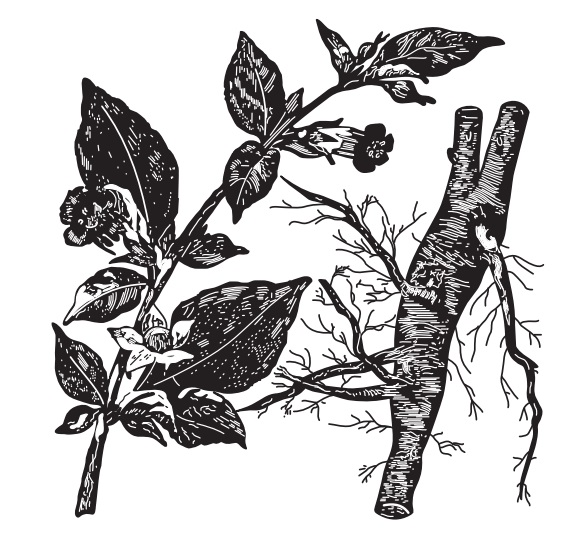Belladonna
| Home | | Pharmacognosy |Chapter: Pharmacognosy and Phytochemistry : Drugs Containing Alkaloids
Belladonna consists of dried leaves and flowering tops of Atropa belladonna Linn. (European Belladonna), belonging to family Solanaceae. It contains about 0.35% of total alkaloids calculated as hyoscyamine.
BELLADONNA
Synonyms
Belladonna herb; Belladonna leaf; Deadly night shade leaves;
Banewort; Death’s herb, Dwale; Poison black cherry; Folia belladonnae.
Biological Source
Belladonna consists of dried leaves and flowering tops of
Atropa belladonna Linn. (European Belladonna), belonging to family Solanaceae.
It contains about 0.35% of total alkaloids calculated as hyoscyamine.
Geographical Source
A . belladonna is cultivated in United States, Canada, UK,
Germany and India.
Cultivation and Collection
Plants are cultivated by sowing seeds in nurseries and
seed-lings are transplanted in April to moist, calcareous and loamy soil. Weeds
are removed and manure is applied for proper growth of the crop. During flowering
session leaves and flowering tops are cut at least three times in a year at an
interval of two months from one to three years old plants. When the plant is
four years old, roots are dug out. The collected drug is dried at 40–50°C.
Un-dried leaves deterio-rate and give off ammonia. Belladonna plant infected
with the fungus Phytophthora belladonnae should be destroyed to prevent further
infection. Sometimes the leaves are damaged by flea-bettle insect and the roots
by a fungus.
Characteristics
The drug contains leaves, smaller stems of about 5 mm
diameter, flowers and fruits. Leaves are stalked, brittle, thin, entire,
long-pointed, 5–25 cm long, 2.5–12 cm wide, ovate lanceolate, slightly
decurrent lamina, margine-entire, apex acuminate, colour dull-green or
yellowish-green, surface glabrous, lateral veins join the midrib at an angle of
60°C, curving upwards and are anastomose. The upper side is darker than the
lower. Each has a petiole about 0.5–4 cm long and a broadly ovate, slightly
decurrent lamina about 5–25 cm long and 2.5–12 cm wide. The margin is entire
and the apex acuminate. A few flowers and fruits may be present. If the leaves
are broken, they are characterized by the venation and roughness of the surface
due to the presence of calcium oxalate in some mesophyll cells which causes
minute points on the surface of the leaf on drying. The flowers blooming in
June are solitary, shortly stalked, drooping and about 2.5 cm long. The corolla
is campanulate, five-lobed and of a dull purplish colour. The five-lobed calyx
is persistent, remaining attached to the purplish-black berry. The fruit is
bilocular, contains numerous seeds and is about the size of a cherry. A yellow
variety of the plant lacks the anthocyanin pigmentation.

Microscopy
A transverse section of the leaf of A. belladonna has a bifacial structure. The epidermal cells
have-wavy walls and a striated cuticle. Anisocytic type and some of the
anomocytic type stomata arc present on both surfaces but are most common on the
lower. Hairs are most numerous on young leaves, uni-seriate, two- to
four-celled clothing hairs; or with a uni-cellular glandular head. Some hair
has a short: pedicel and a multicellular glandular head. Certain of the cells
of the spongy mesophyll are filled with micro-sphenoidal (sandy) crystals of
calcium oxalate. The midrib is convex above and shows the usual bicollateral
vascular bundle. A zone of collenchyma is present in epidermis near midrib.
Chemical Constituents
Belladonna contains 0.3–1.0% total alkaloids, the prominent
base is l-hyoscyamine and other components are atropine, apoatropine, as
choline, belladonnine, cuscohygrine, chrysa-tropic acid, volatile bases, such
as atroscine, leucatropic acid; phytosterol, N-methylpyrroline, homatropine,
hyoscyamine N-oxide, rutin, kaempferol-3-rhamnogalactoside and 7-glu-coside,
quercetin-7-glucoside, scopoletin, calcium oxalate, 14% acid soluble ash and 4%
acid-insoluble ash. Addition of ammonia to the alcoholic solution of scopoletin
shows blue florescence. This test is useful to detect Belladonna poisoning.
Atropine is formed by racemization during the extraction process.
Pppppppppppppppppppppppppppppppppppppppppppppppppppp
Uses
The drug is used as adjunctive therapy in the treatment of
peptic ulcer; functional digestive disorders, including spastic, mucous and
ulcerative colitis; diarrhoea, diverticulitis and pancreatitis. Due to
anticholinergic property, it is used to control excess motor activity of the
gastrointestinal tract and spasm of the urinary tract.
Belladonna is anticholinergic, narcotic, sedative, diuretic
mydriatic and used as anodyne and to check secretion. Other uses are similar to
Hyoscyamus. It relieves spasm of gut or respiratory tract. Consumption of
Belladonna checks excessive perspiration of patients suffering from
tuberculosis. Belladonna acts as a parasympathetic depressant.
Marketed Products
It is one of the ingredients of the preparation known as
Belladona plaster (Surgi Pharma) for backache, stiffness of muscles and boil,
swollen joints.
